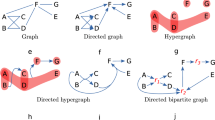Abstract
The aim of this text is to show the central role played by networks in complex system science. A remarkable feature of network studies is to lie at the crossroads of different disciplines, from mathematics (graph theory, combinatorics, probability theory) to physics (statistical physics of networks) to computer science (network generating algorithms, combinatorial optimization) to biological issues (regulatory networks). New paradigms recently appeared, like that of ‘scale-free networks’ providing an alternative to the random graph model introduced long ago by Erdös and Renyi. With the notion of statistical ensemble and methods originally introduced for percolation networks, statistical physics is of high relevance to get a deep account of topological and statistical properties of a network. Then their consequences on the dynamics taking place in the network should be investigated. Impact of network theory is huge in all natural sciences, especially in biology with gene networks, metabolic networks, neural networks or food webs. I illustrate this brief overview with a recent work on the influence of network topology on the dynamics of coupled excitable units, and the insights it provides about network emerging features, robustness of network behaviors, and the notion of static or dynamic motif.
Similar content being viewed by others
References
Albert R., Barabasi A.L. (2001) Statistical mechanics of complex networks. Rev. Mod. Phys. 74, 47–97
Aldana M. (2003) Dynamics of Boolean networks with scale free topology. Physica D 185, 45–66
Aldana M., Coppersmith S., Kadanoff L.P. (2003) Boolean dynamics with random couplings. In: Kaplan E., Marsden J.E., Sreenivasan K.R. (eds) Perspectives and Problems in Nonlinear Science. A celebratory volume in honor of Lawrence Sirovich. Springer, Berlin Heidelberg New york
Barabasi A.L., Albert R. (1999) Emergence of scaling in random networks. Science 286, 509–512
Berg J., Lassig M. (2004) Local graph alignment and motif search in biological networks. Proc. Natl. Acad. Sci. USA 101, 14689–14694
Bollobas B. (2001) Random Graphs. Cambridge University Press, Cambridge
Carvunis, A.R., Latapy, M., Lesne, A., Magnien, C., Pezard, L.: Dynamics of three-state excitable units on random vs power-law networks. Physica A (2005 in press). Available at http://www.liafa.jussieu.fr/~latapy/index.php?item=publis&lang=fr
Ciliberti S., Caldarelli G., De Los Rios P., Pietronero L., Zhang Y.C. (2000) Discretized diffusion processes. Phys. Rev. Lett. 85, 4848–4851
Dorogovtsev S.N., Mendes J.F.F. (2003) Evolution of Networks: from Biological Nets to the Internet and WWW. Oxford University Press, Oxford
Erdös P., Rényi A. (1960) On the evolution of random graphs. Publ. Math. Inst. Hung. Acad. Sci. 5, 17–61
Ermentrout G.B., Edelstein-Keshet L. (1993) Cellular automata approaches to biological modelling. J. Theor. Biol. 160, 97–133
Faloutsos M., Faloutsos P., Faloutsos C. (1999) On power-law relationships of the Internet topology. Comput. Commun. Rev. 29, 251–262
Farkas I., Derényi I., Jeong H., Neda Z., Oltvai Z.N., Ravasz E., Schrubert A., Barabasi A.L. (2002) Networks in life: scaling properties and eigenvalues spectra. Physica A 314: 25–34
Fox Keller E. (2005) Revisiting “scale-free” networks. BioEssays 27, 1060–1068
García-Pelayo R., Stadler P.F. (1997) Correlation length, isotropy and meta-stable states. Physica D 107, 240–254
Gaveau B., Lesne A., Schulman L.S. (1999) Spectral signatures of hierarchical relaxation. Phys Lett A 258: 222–228
Gaveau B., Schulman L.S. (2005) Dynamical distance: coarse grains, pattern recognition and network analysis. Bull. Sci. Math. 129, 631–642
Guelzim N., Bottani S., Bourgine P., Képès F. (2002) Topological and causal structure of the yeast transcriptional regulatory network. Nat. Genet. 31, 60–63
Guhr T., Müller-Groeling A., Weidenmüller H.A. (1998) Random-matrix theories in quantum physics: common concepts. Phys. Rep. 299, 189–425
Hopfield J.J. (1982) Neural networks and physical systems with emergent collective computational abilities. Proc. Natl. Acad. Sci. USA 79, 2554–2558
Imbert, J.B., Lesne, A.: Improved ergodicity in constrained Monte Carlo sampling (2006, in preparation)
Jeong H., Tombor B., Albert R., Oltvai Z.N., Barabasi A.L. (2000) The large-scale organization of metabolic networks. Nature 407, 651–654
Kauffman S.A. (1993) The Origins of Order: Self-organization and Selection in Evolution. Oxford University Press, Oxford
Lesne A. (1998) Renormalization Methods. Wiley, New York
Lesne, A.: Disordered random graph models: scale-free out with a typical in-degree (2006, submitted)
Lesne, A.: Scale-invariant behavior of scale-free graphs (2006, submitted)
Lieberman E., Hauert C., Nowak M.A. (2005) Evolutionary dynamics on graphs. Nature 433, 312–316
Marr C., Hütt M.T. (2005) Topology regulates pattern formation capacity of binary cellular automata on graphs. Physica A 354, 641–662
Mazurie A., Bottani S., Vergassola M. (2005) An evolutionary and functional assessment of regulatory network motifs. Genome Biol. 6, R35
Newman M.E.J. (2003) The structure and function of complex networks. SIAM Rev. 45, 167–256
Papin J.A., Reed J.L., Palsson B. (2004) Hierarchical thinking in network biology: the unbiased modularization of biochemical networks. Trends Biochem Sci. 29, 641–647
Pastor-Satorras R., Vespignani A. (2004) Evolution and Structure of the Internet. Cambridge University Press, Cambridge
Pimm S.L. (1982) Food Webs. Chapman & Hall, London
Schnakenberg J. (1976) Network theory of microscopic and macroscopic behavior of solutions of master equations. Rev. Mod. Phys. 48, 571–585
Shen-Orr S., Milo R., Mangan S., Alon U. (2002) Network motifs in the transcriptional regulation network of Escherichia coli. Nat. Genet. 31, 64–68
Shmulevich I., Kauffman S.A., Aldana M. (2005) Eukaryotic cells are dynamically ordered or critical but not chaotic. Proc. Natl. Acad. Sci. USA 102, 13439–13444
Simon H.A. (1955) On a class of skew distribution functions. Biometrika 42, 425–440
Simonsen I (2005) Diffusion and networks: a powerful combination!. Physica A 357: 317–330
Sornette D. (2000) Critical Phenomena in Natural Sciences. Springer, Berlin heidelberg Newyork New York
Stadler P.F. (1996) Landscapes and their correlation functions. J. Math. Chem. 20, 1–45
Strogatz S.H. (2001) Exploring complex networks. Nature 410, 268–276
Watts D.J., Strogatz S.H. (1998) Collective dynamics of “small-world” networks.[ Nature 393, 440–442
Weinberger E.D. (1990) Correlated and uncorrelated fitness landscapes and how to tell the difference. Biol. Cybern. 63, 325–336
Author information
Authors and Affiliations
Corresponding author
Rights and permissions
About this article
Cite this article
Lesne, A. Complex Networks: from Graph Theory to Biology. Lett Math Phys 78, 235–262 (2006). https://doi.org/10.1007/s11005-006-0123-1
Received:
Revised:
Published:
Issue Date:
DOI: https://doi.org/10.1007/s11005-006-0123-1




